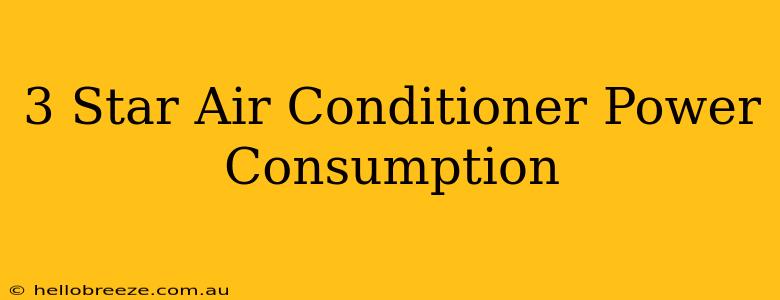Are you in the market for a new air conditioner but concerned about energy costs? Understanding the power consumption of your AC unit is crucial, especially with the increasing focus on energy efficiency. This guide will delve into the power consumption of 3-star air conditioners, helping you make an informed decision.
What Does a 3-Star Rating Mean?
The star rating system, used in many countries, indicates the energy efficiency of an appliance. A 3-star air conditioner falls into the mid-range efficiency category. While not as energy-efficient as higher-rated models (like 5-star), it still offers a decent balance between cooling performance and power consumption compared to older, less efficient units. This makes it a viable option for many consumers.
Factors Affecting 3-Star AC Power Consumption
Several factors influence the actual power consumption of a 3-Star AC, even within the same rating category:
1. Tonnage:
The cooling capacity (or tonnage) directly impacts power consumption. A 1.5-ton 3-star AC will consume less energy than a 2-ton 3-star AC, as it needs to cool a smaller area. Larger spaces require more powerful (and thus more power-hungry) units.
2. Inverter vs. Non-Inverter:
Inverter ACs are generally more energy-efficient than non-inverter ACs. They adjust their compressor speed to match the cooling needs, unlike non-inverter models that run at full power or are completely off. A 3-star inverter AC will likely consume less energy than a 3-star non-inverter AC of the same tonnage.
3. Usage Patterns:
How frequently you use the air conditioner and for how long significantly impacts energy consumption. Setting the thermostat to a reasonable temperature and using it only when necessary can save you considerable money. Consider using it strategically during peak heat hours.
4. Maintenance:
Regular maintenance is crucial for optimal performance and reduced power consumption. Cleaning or replacing filters, checking refrigerant levels, and servicing the unit annually can help prevent inefficient operation, which leads to higher energy bills.
Estimating Power Consumption: A Practical Example
Let's imagine a typical 1.5-ton, 3-star non-inverter AC. Its power consumption could range from approximately 1200 to 1600 watts while running at full capacity. However, a similar 1.5-ton, 3-star inverter AC might consume significantly less, perhaps between 800 and 1200 watts at full load. This difference highlights the importance of choosing the right type of AC for your energy efficiency goals.
Remember, these are estimates. The actual power consumption will vary depending on the specific model, usage, and environmental factors. Always check the manufacturer's specifications for precise details.
Choosing the Right 3-Star AC for Your Needs
Before purchasing a 3-star air conditioner, consider the following:
- Room size: Determine the appropriate tonnage needed for your space.
- Budget: Balance the cost of the unit with long-term energy savings.
- Energy efficiency features: Opt for an inverter model for better efficiency.
- Brand reputation: Choose a reputable brand known for its quality and reliability.
By carefully weighing these factors and understanding the power consumption implications, you can select a 3-star AC that meets your cooling needs without breaking the bank. A well-maintained, appropriately sized unit will provide comfortable cooling while minimizing your energy footprint.

